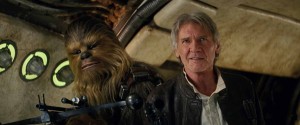
When executive producer Jason McGatlin called production sound mixer Stuart Wilson about an unnamed project he was developing, the conversation was short, but after setting up a time to meet he ended it with, “If you put two and two together, you could maybe guess what it is.” Turns out, it was J.J. Abrams’ Star Wars: The Force Awakens.
Fast-forward to spring the following year, Wilson and his team, Orin Beaton, Tom Fennell and David Giles found themselves in 120 degree heat of the Abu Dhabi desert on the first day of principle photography. “Nobody knew what to expect. We took far too much equipment because we wanted to be ready for everything. The conditions were tough and we worked from dawn to dusk, but it really bonded the crew,” Wilson recalled. The remote Abu Dhabi locations stood in for planet Jakku where we meet Rey (Daisy Ridley), a lone girl pawning salvage for scraps for food. “It was so warm there I had to pack my equipment with bottles of water around it so it would keep going.”
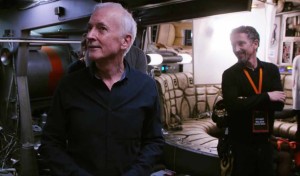
While locations had their challenges, sound had to prepare to mic an endless crowd of characters. Some we all know and love and others brand new – one being BB-8. During filming, production used five different BB-8 models for the actors to interact with. “We put a receiver and a speaker system into each one and gave J.J. a tablet where he could trigger sounds or use a live microphone depending on the situation.” Post provided voice ideas for BB-8 loaded into Beat Maker Pro which were later refined during editing. “At the end of the day, one of the puppeteers, Brian Herring, brought so much life to BB-8, we ended up micing him and laying it down on a separate track for post.”
With C-3PO Wilson wanted to make sure actor Anthony Daniels was as comfortable as possible. “Anthony talked to me about some of the early days when the mask really didn’t allow him to hear what was going on. People would walk away to lunch and he would be left standing there not knowing what was happening. I thought C-3PO should have this super-hearing and be able to focus in on what’s important so I did a separate mix into an ear piece for him.” To provide life for his voice, the sound department took apart an Audio Ltd miniTX transmitter and spread the components inside the mask so it could fit into the tight space, then placed a lav to track his dialogue.
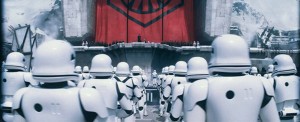 While prepping to mic Chewbacca (Peter Mayhew) they looked to animatronic design supervisor Maria Cork for help. “Maria is very skilled and patient. In order to build Chewbacca’s head, she sews each individual hair one by one into the mask. She sewed in the right color mic and built the first windshield made from Wookiee fur,” Wilson laughed. “It worked great when we needed to record outside dialogue.”
While prepping to mic Chewbacca (Peter Mayhew) they looked to animatronic design supervisor Maria Cork for help. “Maria is very skilled and patient. In order to build Chewbacca’s head, she sews each individual hair one by one into the mask. She sewed in the right color mic and built the first windshield made from Wookiee fur,” Wilson laughed. “It worked great when we needed to record outside dialogue.”
The story’s antagonist, Kylo Ren (Adam Driver), also had a mask as part of his costume. “Driver has a great voice and he wore his mask for a lot of the film. We decided to put one mic inside and another on his chest – having two going at all times,” explained the mixer. “When the two mics were in phase and you combined them, it gave his voice this larger than life quality with a lot of bass and presence. It ended up producing a really nice result when we see Kylo Ren try to use the Force against Rey. It really sounds like his voice is inside her head.”
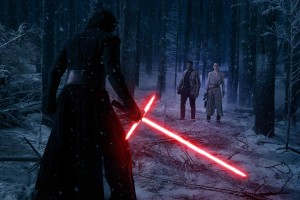 While shooting, production was equipped with two new Panavision Panaflex Millennium XL2 film cameras, one dubbed “Death Star” the other “Millennium Falcon,” and for the majority, they elected a single camera approach operated by Colin Anderson (b camera, Philippe Carr-Forster). “We wired everyone for safe keeping and had two booms going when and where we could,” said Wilson. “J.J. developed a routine in the sense that they would do the shot then shoot a clean plate. After, we would do a wild track if we needed something, for example, if there was a wind machine you couldn’t get around. J.J. never missed a wild track. Even if I had to set something up away from set and grab an actor, he would always be right there directing and listening to what he was getting.”
While shooting, production was equipped with two new Panavision Panaflex Millennium XL2 film cameras, one dubbed “Death Star” the other “Millennium Falcon,” and for the majority, they elected a single camera approach operated by Colin Anderson (b camera, Philippe Carr-Forster). “We wired everyone for safe keeping and had two booms going when and where we could,” said Wilson. “J.J. developed a routine in the sense that they would do the shot then shoot a clean plate. After, we would do a wild track if we needed something, for example, if there was a wind machine you couldn’t get around. J.J. never missed a wild track. Even if I had to set something up away from set and grab an actor, he would always be right there directing and listening to what he was getting.”
The biggest scene technically for sound was when our heroes land on planet Tokodana to meet with Maz (Lupita Nyong’o) inside a crowded alien bar. “There was a tremendous amount of planning and preparation went into that sequence,” said Wilson. “We had musicians, creatures, and other droid characters to contend with besides our principles and then the eventual raid by the First Order. The musicians needed to hear the music, but we didn’t want it playing in the room as I needed to record clean dialogue. The puppeteers needed to be able to speak to their respective ‘creatures’ to give them voices and issue instructions, but without the instructions being audible on set. And anyone with an animatronic head needed an in-ear feed just to be able to know what was going on.” Sound even rigged Abrams with a key panel so he could give notes to anyone directly. “With planning and preparation my team did a great job of rigging as much as possible off-set so that when the performers took the stage they could just enter into the scene without distractions and then I could record the great performances from Harrison, Daisy, John, and the others.”
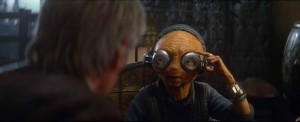 When they found themselves in tight spaces, like the Millennium Falcon or inside a cockpit, plant mics were used with additional mics placed inside the pilot’s helmet. “David is the biggest fan in my team,” said Wilson. “When we were building the mics inside the fighter pilot’s helmets, we had to test them and what better way to test them by sitting in the cockpit while you’re doing it. So I sent David to do the job and could see it was a boyhood dream come true. So many people were the biggest fans. You could feel the excitement and love on the project.”
When they found themselves in tight spaces, like the Millennium Falcon or inside a cockpit, plant mics were used with additional mics placed inside the pilot’s helmet. “David is the biggest fan in my team,” said Wilson. “When we were building the mics inside the fighter pilot’s helmets, we had to test them and what better way to test them by sitting in the cockpit while you’re doing it. So I sent David to do the job and could see it was a boyhood dream come true. So many people were the biggest fans. You could feel the excitement and love on the project.”
That excitement started from Abrams and trickled down through the entire crew. “J.J. and first assistant director Tommy Gormley were a delight to work with and J.J. really knows his stuff,” said the mixer. ”We were shooting in a forest near Wales for when Rey gets captured by the First Order and the location had a really nice echo to it. Once I thought everyone had gone I wanted to capture the acoustics by recording some frequency sweep tones among the trees. Then J.J. emerged and causally said, ‘Is that for convolution reverb?’ It was, but there aren’t many directors I’ve worked with who understand these aspects like he does. With sound, you feel like you’re the only one who knows what you’re doing, but to have other people know what you do too is exciting.”
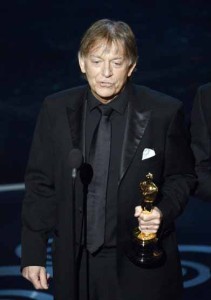
In post rerecording mixers Andy Nelson and Christopher Scarabosio worked vigorously to bring all the sound elements together. “Clarity is always the number one priority in a picture like this,” said Nelson. “In addition to the regular voices you have the creature characters to contend with. Between Chris, [sound designer] Gary Rydstrom, and myself, we decided which characters would go in the sound effects world and which ones would stay in the dialogue world.” Nelson and Scarabosio split duties up so Nelson would take the dialogue driven characters and music and Scarabosio would concentrate on the sound effect characters like BB-8.
“J.J. wanted the audience to feel something,” said Scarabosio. “With a note like that we had to think about what each scene meant to the story and decide what to focus on. We wanted to make sure we didn’t fatigue the audience or drub them over long periods of time.” One of those focusable moments takes place when we first meet Finn as a stormtrooper and he’s holding the bloody hand of his fallen comrade. “We took that scene way down to just Finn’s breathing and a little music with muted sound effects so you know there’s a real importance to this stormtrooper. We wanted to humanize him in a way,” explained Scarabosio.
Another scene with focusable importance was the Force battle between Kylo Ren and Rey. “There isn’t a whole lot going on visually that’s telling the story other than the actors’ facial expressions,” Scarabosio explained. “If you walked into that room, you wouldn’t hear the sounds behind the Force, but with sound as a storytelling tool, you can show the shift in power taking place between Kylo Ren and Rey when she starts pushing back and getting stronger. We wanted to make sure you felt that and realize Rey is special.”
[SPOILER ALERT]
If you haven’t seen the movie by now, what are you waiting for?
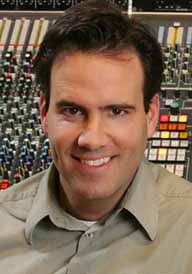
The death of Han Solo also had a layered discussion for sound. “We looked to create a real stillness and clam feeling leading up to the shock,” noted Nelson. “Han’s dialogue had some particularly noisy pieces due to some fans blowing so we did a little looping and very carefully selected a few key moments that allowed us to quiet the scene down. The action then gets calmer and calmer between Kylo Ren and Han. It’s a beautiful device to make you feel a certain way before the unexpected happens. It was a difficult to put together but when the music from John Williams was placed in by [music editor] Ramiro Belgardt, it cradled the scene together so well. What Williams wrote for that moment was so devastating and the shock after when they cut back to Princess Leia, it just breaks your heart.”
In the final mix, Dolby Atmos took center stage with additional mixes for 7.1 and 5.1 taking place down the line. “I don’t care what format I am working in, I work very much on the level of the story. I want the energy to be coming at me from the screen,” said Nelson. “I feel that’s my old fashioned storytelling. I’m not trying to be too clever in a sense. I always think of it in three words – clarity, emotion and excitement. I’m looking to hit all of those in every scene.”
“For something as epic as Star Wars it’s nice to have that extra energy you can produce in Atmos,” added Scarabosio. “J.J. wanted the audience to feel the energy and the excitement – that you’re there with these characters. You ultimately want to create the space for people to enter these worlds and J.J. did such a great with these characters we wanted to make sure the audience felt something.”





